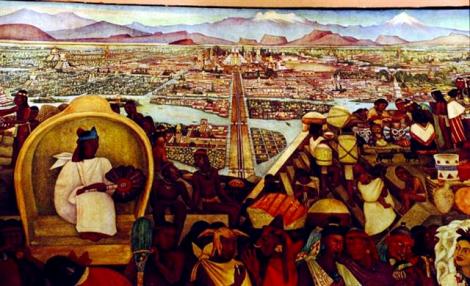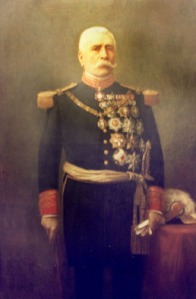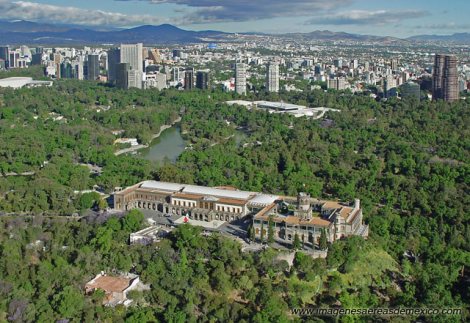Unlike its neighbor to the north, Mexico had at least three revolutions, with the church-state divide playing a strong part in all three. The first revolution (1810-1821) was to throw off the colonial yoke of Spain. It is formally known as the War of Independence and established the First Mexican Empire (1821) followed by the First Mexican Republic (1823). The conflict was mired in the complexities of land ownership, birth (in Spain or in Mexico), miscegenation, and the church.
The War of Independence began on September 16, 1810, when Father Miguel Hidalgo launched the struggle from the small town of Dolores, Guanajuato, by crying out to the townspeople to join him in the fight for independence. Thus, Mexican Independence Day is celebrated on the 16th of September (not on Cinco de Mayo, as is often believed).
Vodpod videos no longer available.
Hidalgo’s rallying cry is know as the Grito, and it is repeated by the President of Mexico every year. In a celebration beginning on the night of the 15th, with much pomp and ceremony, the President shouts Hidalgo’s words from a balcony at the Palacio Nacional overlooking the immense cental plaza in Mexico City know as the Zócalo. The event is aired on live television every year in Mexico and the U.S.
Picture the fact that this event takes place in the center of what was once the Venice-like capital of the former city of Tenochtitlan, next to the largest and oldest cathedral in the Americas, built starting in 1573 from the stones of the most important temple of the Aztec empire.
The Palace itself was the “New Palace” of the Aztec emperor, Moctezuma II, at the conquest, but was substantially rebuilt by Cortés starting in 1521. Much of the current building is much newer, having been reconstructed after a fire in 1692. Compare these vintages to those of the nouveau riches neighbors to the north!
While the Cowboy won’t get into it here, one of the most fascinating reads in history has to be Bernal Diaz’s fascinating first-hand account of encountering, then conquering the Aztec empire.

The new country was fragile, divided and sprawling. Like with the Civil War in the U.S., later instability had its roots in unsettled issues from independence. In the case of the U.S., the key issue was slavery, while in Mexico it was the role of the Roman Catholic Church.
In an effort to settle its most far-flung territories, Mexico allowed immigrants to enter from the United States and settle in the north, provided they did not bring slaves – slavery being illegal in Mexico. These immigrants chafed at Mexican rule and the prohibition against slavery. They eventually rebelled, leading to the declaration of independence and formation of the Texas Republic in 1836, and sowing the seeds for the Mexican-American War.
Once Texas joined the U.S. in 1845, ongoing conflicts over the rebellious Mexican province and its borders came to a head. The U.S declared war on Mexico in 1846 and invaded, eventually capturing Mexico City and occupying much of the country. The six military cadets who escort the President in the National Palace during the Independence Day celebrations are an homage to the six Niños Héroes who were killed by U.S. forces while defending Chapultepec Castle in Mexico City. The castle was built starting in 1785.
As a condition to peace, the U.S. forced Mexico to turn over much of the rest of its northern territory. As such, in the period from 1836 to 1853, the U.S. was able to take advantage of Mexican instability to capture what are now the states of Texas, California, Arizona, New Mexico, Colorado, Nevada and Utah. This immense expansion occurred just before the U.S. entered its own period of instability: the Civil War.
Internal conflicts in Mexico continued and led to the invasion by France in 1862, supported by conservative Mexican allies loyal to the church. The “Cinco de Mayo” holiday actually celebrates the initial victory of Mexican forces against the French – one of the best militaries in the world at the time – in the Battle of Puebla. The French eventually prevailed, however, and with their Mexican sympathizers, they installed a Hapsburg emperor in Mexico and declared it a monarchy: the Second Mexican Empire.
 Benito Juárez, an indigenous lawyer, led the efforts to oust the French and wrest power from the monarchists. The Cowboy thinks of this struggle as the second Mexican revolution. Juárez was able to capture Maximilian and restore the Republic in 1867. During the Empire, Juárez operated from a base in El Paso del Norte and later, Chihuahua. He remained president until he died in 1872, when he was replaced by his vice president. In 1888, El Paso del Norte was renamed Ciudad Juárez in honor of him.
Benito Juárez, an indigenous lawyer, led the efforts to oust the French and wrest power from the monarchists. The Cowboy thinks of this struggle as the second Mexican revolution. Juárez was able to capture Maximilian and restore the Republic in 1867. During the Empire, Juárez operated from a base in El Paso del Norte and later, Chihuahua. He remained president until he died in 1872, when he was replaced by his vice president. In 1888, El Paso del Norte was renamed Ciudad Juárez in honor of him.
 In 1876 an army general by the name of Porfirio Díaz staged a coup, and overthrew the President. Díaz led a dictatorship for over 30 years (1876-1911) – a period often called the Porfiriato. Despite the loss of the Republic and democracy, Díaz brought stability. In the modern era, one can’t help but think of the conflicted feelings in Chile regarding Augusto Pinochet.
In 1876 an army general by the name of Porfirio Díaz staged a coup, and overthrew the President. Díaz led a dictatorship for over 30 years (1876-1911) – a period often called the Porfiriato. Despite the loss of the Republic and democracy, Díaz brought stability. In the modern era, one can’t help but think of the conflicted feelings in Chile regarding Augusto Pinochet.
Eventually, however, in 1911 Francisco Madero started what came to be known formally as the Mexican Revolution. The Cowboy thinks of this as the third revolution. Porfirio Díaz was ousted by Madero, who had planned the overthrow in exile in San Antonio, Texas. Porfirio Díaz escaped Mexico, but decided on the Seine rather than the San Antonio River for his exile, bringing France back into the story (if only briefly).
After the Porfiriato, Mexico underwent a terrible period of unrest. The Revolution lasted until around 1921, killing an estimated 900,000 people. At that point, Álvaro Obregón became president. In 1928, the city of Cajeme in the northern state of Sonora (just south of Guaymas) was renamed Ciudad Obregón in honor of the former president, whose birthplace was nearby.
Generals John J. Pershing, Pancho Villa, and Álvaro Obregón pose for a photo at Fort Bliss, Texas, 1913
Other notable figures from this period were Pancho Villa, Emiliano Zapata, Victoriano Huerta, and the man whose name is the Cowboy’s favorite among Mexican historical figures: Venustiano Carranza! (Must always be said with a flourish.) Pancho Villa, the governor of Chihuahua state, was an ally of the United States until Woodrow Wilson changed U.S. tactics. Also during this period, the U.S. invaded Mexico again, taking the port city of Veracruz and marching deep into Mexico from the north under the leadership of Villa’s one-time friend from El Paso, General John Pershing.
 And if you’re still looking for intrigue, there’s always the Zimmerman Telegram: Kaiser Wilhelm’s attempt to enlist Venustiano Carranza (!) as an ally with a promise of the return of its former northern territories upon victory against the U.S. Pershing got back at the Kaiser by taking his own experiences fighting in Mexico to Europe, leading the American Expeditionary Force against Germany in World War I and serving as mentor to the generals who defeated Germany in World War II, including Bradley, Eisenhower, Marshall and Patton.
And if you’re still looking for intrigue, there’s always the Zimmerman Telegram: Kaiser Wilhelm’s attempt to enlist Venustiano Carranza (!) as an ally with a promise of the return of its former northern territories upon victory against the U.S. Pershing got back at the Kaiser by taking his own experiences fighting in Mexico to Europe, leading the American Expeditionary Force against Germany in World War I and serving as mentor to the generals who defeated Germany in World War II, including Bradley, Eisenhower, Marshall and Patton.
On several occasions, the Cowboy had the pleasure of encountering one of Pershing’s protégés, Omar Bradley, in Pershing’s old stomping ground near the Rio Bravo del Norte.
And now we come to the crux of our story.



